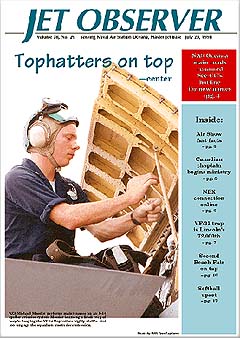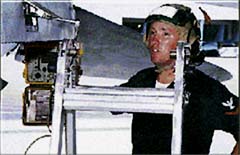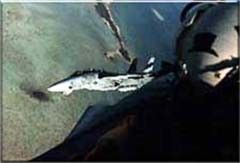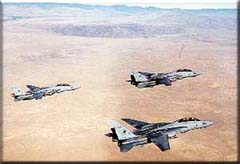| Truly a banner
year for the Tophatters!  Last month the
Tophatters of VF-14 made it on the cover of the NAS Oceana Jet
Observer with a knock-out title : Tophatters on
Top ! Here's a shot of that cover and you can
read below the cover story, as published by the
magazine and posted online by the NAS
Oceana Jet Observer Online. Last month the
Tophatters of VF-14 made it on the cover of the NAS Oceana Jet
Observer with a knock-out title : Tophatters on
Top ! Here's a shot of that cover and you can
read below the cover story, as published by the
magazine and posted online by the NAS
Oceana Jet Observer Online.
Year of
the Lid
by Lt. Mark Mineo
VF-14 PAO
as published by
the NAS Oceana Jet Observer Online.

It has been, by any standard, a banner year
for the Tophatters of VF-14. When Commander Naval
Air Force, U.S. Atlantic Fleet Vice Adm. John
Mazach visited Fighting Fourteen at the end of
May to present the Battle
Efficiency award, he underscored a series of
honors, both large and small, that have marked a
truly extraordinary year in the life of the
Navy's oldest active-duty fighter squadron. The
Tophatters officially won the Battle "E" at
the end of February. They were presented the most
coveted trophy of excellence in the fighter
community - the Admiral
Joseph C. Clifton award - at the Association
of Naval Aviation (ANA) convention in May.
And this award was soon followed by an equally
prestigious and exceptional honor - the Arleigh Burke Fleet Trophy,
awarded annually to the most improved combat unit
(ship, submarine, or squadron) in Commander in
Chief, U. S. Atlantic Fleet (CINCLANTFLT). This
award has never been won by an F-14 squadron, and
it is perhaps this last award which says the most
about where Fighting Fourteen has been and where
it is going as the squadron sails into the next
millennium.

AT3 Larry Craft performs missile system
operational checks.
As recently as 1995, Fighting Fourteen was
slated to end its long tradition of service and
disestablish. The squadron had not deployed since
early 1993, and most of its jets were going into
preservation. It is the sense of mission which
breathes life into any naval unit, and that
mission was sorely lacking at VF-14. "It was
a pretty tough place to do business,"
relates Lt. Richard Simpson, who departed the
squadron last October. "We only had nine
jets, and six were in preservation. If we wanted
to bring one jet out of preservation, we had to
put another back. We didn't have much money,
spare parts, or support equipment. And we were
losing a lot of people because of the anticipated
decommissioning."
Fortunately for morale, things started to
change when Cmdr. Emmitt Dickens took command in
early '95 and announced that Fighter Squadron
Fourteen would not be decommissioning. Under his
leadership, the squadron started to volunteer for
any detachments possible. The challenges involved
in this about-face were numerous. Aircrew, who
had not had the opportunity to garner as many
hours as their community counterparts, had to
work on proficiency. Some hadn't operated around
a carrier in years. And with the money to bring
its jets out of preservation and ramp up to a
full squadron complement, VF-14's manning problem
was initially exacerbated. "We were
stretched pretty thin," notes Master Chief
Ted Prince, "we had fifteen jets, and we
were only manned for ten. But we kept pushing it
... at one point we conducted a missile shoot in
which we launched ten missiles and dropped
several thousand pounds of live ordnance in one
day."
The Tophatters were determined to stage a
comeback, and it wasn't long before their
motivation and professionalism earned
recognition. Fighting Fourteen sent a detachment
to the Marine Corp's Twenty Nine Palm
Expeditionary Airfield (EAF) in support of the
Corp's Combined Arms Exercise in the Fall of '95
(CAX 9-95), taking the place of a previously
scheduled Harrier squadron. "They invited us
back," recalls Lt. John McFadden. "It
was hot - extremely hot. We were living in tents,
and operating off a runway made of aluminum
matting. But we did well...the Marines really
liked our extended on station time, and we
dropped an unbelievable amount of ordnance."
Indeed...over a three-week period, the Tophatters
dropped over 156,000 pounds and flew 200 sorties.
It was a truly crushing amount of close air
support.

Two VF-14 Grumman F-14A Tomcats perform low
altitude
maneuvres over the Med during the 1997 cruise.
But it wasn't the same as operating off the
boat - an area in which the Tophatters were still
rated as underdogs. "When the squadron
joined Carrier Wing Eight in early '96,"
recalls Lt. j.g. Todd McKellar, VF-14's
maintenance material control officer, "a lot
of people thought it was destined for
failure." Fortunately, Fighting Fourteen
dispelled this notion in February of '96 when it
successfully completed the first sea trials in
almost three years aboard USS John C. Stennis.
"That at sea period really established
us," explains Commanding
Officer Cmdr. Luke Parent. "It was our
first opportunity to deploy as members of an
airwing, and our people were hungry. They wanted
to prove that they weren't the Air National
Guard, but a sea-going, war-fighting squadron.
They did well."
And they continued to do well under the
leadership of Cmdrs. John
Snedeker and Luke
Parent, from the brief North Atlantic
deployment which took them on an inspiring port
visit to Dublin, Ireland, to the cruise work-up
cycle which then-Skipper Snedeker
liked to characterize as "the long road to
the Mediterranean." The Spring '97
deployment which followed was no disappointment.
As Parent took command
of VF-14 in July of '97, the squadron was well on
its way to establishing its CVW-8 leading 98.7
percent sortie completion rate, and under the new
skipper, it only continued to excel. The squadron
developed and implemented new tactics utilizing
LANTIRN, the Tomcat's new precision targeting
system, logging an unprecedented amount of
LANTIRN hours throughout the deployment - over
1300 hours in 800 sorties. Peace keeping missions
over Bosnia-Herzegovina and Iraq resulted in 100%
target acquisition on all assigned targets. The
squadron led air wing detachments with allies and
friends in Landivisiau, France, and Oman, Jordan.
VF-14 planned and ex-ecuted operation
"Beacon Flash," the most intensive
joint exercise with the nation of Oman in a
decade. And this effort was supported by a
Maintenance Department that won three consecutive
Carrier Air Wing Eight Golden Wrench Awards
during deployment, and went on to win the 1997
Commander Fighter Wing Atlantic Golden Wrench Award.
Clearly, if the Tophatters had once been the
untested members of Air Wing Eight, by the end of
cruise they had proven that they could be relied
on for leadership and excellence in all aspects
of strike/fighter aviation.

three VF-14 Grumman F-14A Tomcats over the NAS El Centro
range
during SFARP deployment in 1998
And what is the key to such an amazing turn
around? "There's no doubt about it,"
explains Parent,
"we were blessed with an amazing amount of
talent. Every member of this command has been
instrumental to its success. The backbone of the
squadron is certainly the Maintenance
Department, and our maintainers have been
awesome - they just don't quit when it comes to
providing, day after day, consistently excellent
aircraft. And our other departments show the same
dedication. There's a real spirit of quiet,
confident professionalism...people taking pride
in what they do."
They
have a lot to be proud of.
related
items on this site:
Command History,
VF-14 awards, Arleigh
Burke Fleet Trophy, Admiral Clifton award, Battle
E,
Med Cruise &
Change of Command
related
links :
 the NAS Oceana Jet
Observer online the NAS Oceana Jet
Observer online
|